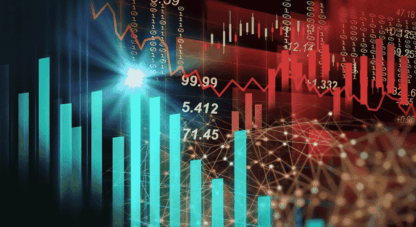The important thing to realize about economic policy is that it’s not just about abstract theory that policy junkies throw around behind closed doors. It’s not just about numbers and rates. And it’s not just about endless discussions of what’s happening or what will happen tomorrow in the stock or bond or real estate market. As Ludwig von Mises told us in his book by the same name, it’s about human action. By extension, it’s about human choices and human consequences. In short, it’s about life.
That fact seems to get lost in Washington DC as policies are enacted to attain certain ends. It also gets lost in the Eccles Building as interest rate changes are implemented to attain certain ends. Most of the time, both of these sets of efforts tend to promote today’s priorities rather than tomorrow’s, which means that the future is sacrificed for the present. And lost in that fact is the ostensibly minor point that the future sacrificed belongs to human beings—hundreds of millions of them.
Decisions made now are affecting payments people will make for 30 years on most new mortgages. Pension funds are being deeply affected by the stock market’s decline due to the end of easy money. Tuition increases are causing many young people to forego a college education. Inflation is causing consumers to use up their savings and not save as much for the future. And much more.
Granted, these are not the ends desired by either the government or the Fed. Still, they were foreseen by millions of Americans not blinded by greed or power, or sated by good times purchased at the cost of the future. Readers of Adam Smith, Ludwig von Mises, F.A. Hayek, and Murray Rothbard have known how this would all end. Much more than that, scores of millions of children were taught by their parents that, “there’s no such thing as a free lunch.” Many of them apparently forgot the lesson, but not all.
The bottom line is that this was all preventable. It was made to happen by people who asserted that they could save the world—maybe—but certainly at a profit. The world wasn’t saved. It was just shown a roaring good time—for today. Its savings for tomorrow went into the pockets of those who provided the entertainment. Now it has neither good times nor savings, while rich policymakers, corporate bigwigs, trust fund nabobs, and crony-capitalist billionaires cry “oops” all the way to the bank. And the “solution” to this inequity that most opportunists now offer is socialism, which effectively tips the nation out of the very hot frying pan into the very hot fire.
Many Americans can’t be bothered to read any of the authors listed above. They can’t even abide by their parents’ admonition to pay for lunch. So they certainly won’t be reading the analysts below who translate complex policy, events, and theory into easily understood English, and apply logic and reason to developments rooted in fantasy and emotion. Fortunately, there are some who will read these insightful publications. We hope you’ll join them. Don’t miss this week’s crucial installments. Just click on one or more of the links below.
Key Takeaways:
- Bank lending is way, way down
- Difficulty is threatening to turn into dysfunction in markets
- Did the Fed foresee its current situation decades ago?
- The US is alienating friends and creating enemies
The McAlvany Weekly Commentary: With apologies to Jerry Lee Lewis, there’s a whole lotta shakin’ goin’ on in the world of bank credit. Or perhaps shakin’ isn’t the right word. Shrinkin’ is more like it. David and Kevin note that the Fed’s most recent H.8 report, which details assets and liabilities in commercial banks, is highly significant. “US bank lending contracted by the most on record in the last two weeks of March, indicating a substantial tightening of credit conditions in the wake of several high-profile bank collapses. Commercial bank lending dropped nearly 105 billion in the two weeks ended March 29th, the most in Federal Reserve data back to 1973.” In that regard, David notes that, “As goes 2023 bank lending, so goes the economy. Recession in the second half is not a wild guess. It’s the implication of last year’s record bank lending of $1.4 trillion coming to a grinding halt.” That’s big. It’s really big. And it’s as clearly and concisely stated as you’ll see or hear anywhere.
Credit Bubble Bulletin: Recounting a decade-long interest rate history that he analyzed extensively and wrote about in detail, Doug springboards into penetrating commentary on current economic events: “I worry most about a mounting systemic crisis of confidence in monetary policy, government debt, market structure, and finance more generally. I see hopelessly dysfunctional markets, distorted from years of low rates, interminable liquidity excess, and habitual market interventions and bailouts. I fear a stock market incapable of adjustment, increasingly vulnerable to dislocation and panic. I see a Treasury market where yields are completely divorced from an unending massive supply of new debt securities. Devoid of market discipline, Washington politicians will continue to bankrupt the country in debt and inflation.” No candy-coating here, but if you want to know what’s really going on, there’s no better place to find out.
Hard Asset Insights: Framing his analysis this week in the commonsensical and easy-to-understand terms of Austrian economics, Morgan makes clear that our economic course of the past several decades cannot continue. And building on the famous truism that “what cannot continue will stop,” he describes what the anticipated end will look like. It’s not pretty. Given that the dollar is the world’s reserve currency and that it has backstopped national economies around the globe, its demise will be problematic far beyond the borders of its home country. None of this should come as a surprise. To show just how predictable it was, Morgan reaches back to the Fed’s own analysis of 42 years ago. “In 1981, a Minneapolis Fed white paper observed that once Federal debt gets so high that lower interest rates are required to both service the debt and keep economic growth positive, the central bank’s ability to control inflation becomes compromised.” There’s more—much more. Don’t miss this combination of meticulous research and cogent analysis.
Golden Rule Radio: Miles and Rob take a long hard look at the US government’s fiscal health, with particular emphasis on its debt payments. After the Fed’s interest rate increases over the past year, those payments now represent one of the highest outlays by the federal government. In light of these fiscal health problems, the BRICS countries along with Iraq and Saudi Arabia are getting bolder in their willingness to challenge the petrodollar system—and by extension the entire dollar-as-world-reserve-currency system. Notable in that observation, the hosts point out, is India—the “I” in BRICS—which has long been on friendly trade terms with the US. Coincident with these developments, the dollar has been losing ground and gold has gladly been moving onto that ground. Both hosts anticipate possible pullbacks in gold’s advance, but only temporarily.















